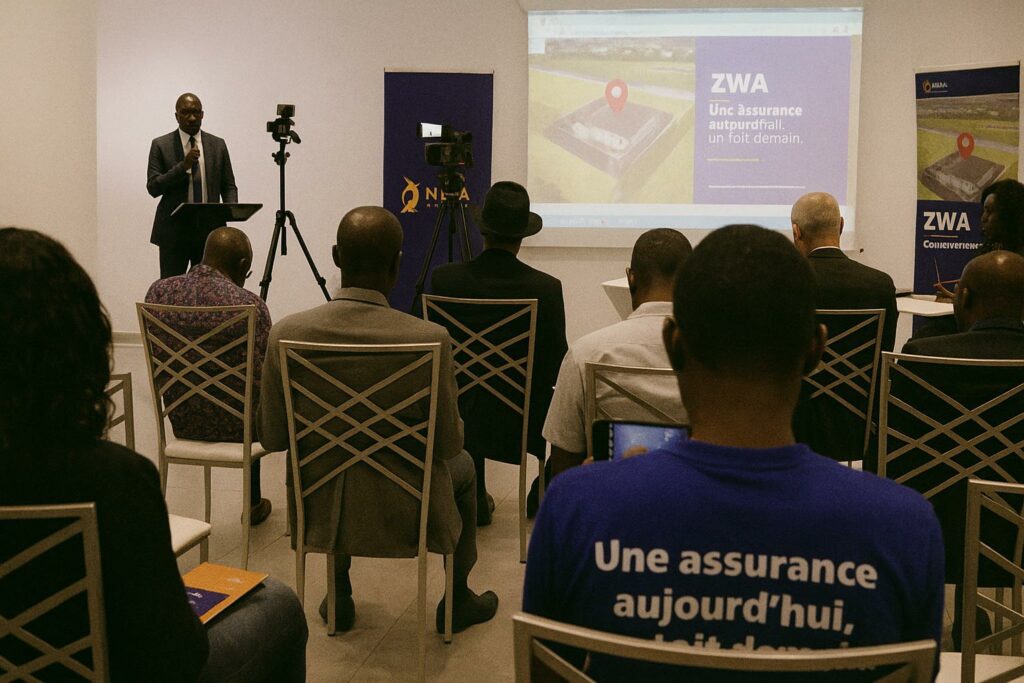Insurance penetration remains thin in Brazzaville’s financial skyline
At barely one percent of GDP, insurance penetration in Congo-Brazzaville lags behind the continental average of three percent, according to recent estimates from the African Insurance Organisation and corroborated by World Bank macro-financial datasets (World Bank 2022). The low uptake reflects a regional hesitancy to formalise risk management, where informal community networks still absorb most shocks related to illness or death. Insurers therefore face a dual challenge: demystifying their products and aligning premiums with the modest disposable incomes that characterise the largely informal urban and peri-urban economy.
Zwa Lopango: a marketing gambit or social innovation?
Into this landscape steps NSIA Vie, an Ivorian-rooted but locally incorporated insurer that already controls nearly a quarter of Congo’s life-insurance market, according to the Conférence Interafricaine des Marchés d’Assurances (CIMA 2023). Its new campaign, evocatively titled “Zwa Lopango” in Lingala—loosely translatable as “take the plot”—offers funeral-expense cover from as little as 10,000 CFA francs, roughly the price of an urban day-labourer’s weekly lunch allowance. Every new subscriber is automatically entered into a quarterly draw for a parcel of land, an asset that resonates deeply with Congolese conceptions of intergenerational wealth and social status.
Cultural symbolism of land in Congolese risk perception
From Pointe-Noire’s rapidly expanding suburbs to Brazzaville’s peri-urban corridors, the acquisition of land remains a primary aspiration for households seeking both security and prestige. Sociologists at the Université Marien-Ngouabi argue that land grants social legitimacy in a way cash payouts seldom do (Mbemba 2021). By coupling life cover to the prospect of a deed, NSIA Vie leverages a cultural archetype: safeguarding one’s lineage through tangible soil. For marketing strategists, the raffle is less a gimmick than a semiotic bridge translating abstract insurance principles into a lived Congolese narrative of patrimony.
Aligning with Brazzaville’s inclusive-growth discourse
Since the 2021–2025 National Development Plan was unveiled, Brazzaville has emphasised financial inclusion as a pillar of its diversification agenda. The Ministry of Finance’s Roadmap for Insurance Modernisation calls for doubling the number of policyholders by 2025 (MinFin 2022). In this light, NSIA Vie’s strategy dovetails neatly with government priorities, supporting President Denis Sassou Nguesso’s stated objective of cushioning vulnerable households against idiosyncratic shocks without burdening public finances. Diplomats in the city note that private-sector initiatives of this nature also serve as confidence signals to international creditors engaged in Congo’s external-debt negotiations.
Commercial viability under CIMA prudential ratios
Sceptics might question the sustainability of offering meaningful death-benefit cover at a 10,000 CFA entry point. Yet actuarial models shared by industry insiders suggest that a broad subscriber base of 50,000 individuals could generate sufficient premium float to underwrite both claims and the cost of the land lots, while still respecting CIMA solvency margins set at 100 percent of the minimum capital requirement (CIMA Code, Article 329). Management asserts that the land parcels earmarked for the raffle have been acquired at concessional rates in satellite districts, minimising balance-sheet strain.
Regulatory safeguards and consumer-protection angles
The National Insurance Directorate has welcomed the initiative, but regulators underscore the need for transparent draw procedures and prompt claim settlement to shore up public trust. Independent auditors from KPMG Congo have been retained to supervise the October 15 draw date disclosed at launch, a move likely aimed at pre-empting fraud allegations that occasionally dog regional lotteries. Consumer-rights associations, while broadly supportive, advocate for simplified policy wording to mitigate mis-selling risk, noting that literacy gaps remain a formidable barrier to uptake.
Diplomatic and macroeconomic resonance
For external observers, micro-insurance schemes of this kind have geopolitical subtext. Development partners view them as complementary social-safety nets, potentially easing fiscal pressure in times of crisis. The International Monetary Fund’s Article IV consultation last year urged greater private-sector participation in social-protection delivery (IMF 2023). By signalling regulatory openness and market creativity, Congo-Brazzaville positions itself as an incubator for blended financial-inclusion models in Central Africa, a narrative that could reinforce its standing in forthcoming Economic and Monetary Community of Central Africa negotiations on cross-border insurance harmonisation.
Beyond the raffle: can trust outlive the marketing cycle?
Ultimately, the lasting metric will not be the quarterly photo-op with a jubilant land-winner but the retention rate once the novelty wanes. If the campaign succeeds in recasting insurance as an act of familial solidarity rather than a distant corporate promise, it may well recalibrate Congolese household budgets in favour of formal risk-pooling. That, in turn, would advance the government’s quest for a more resilient and financially literate populace, while opening fresh revenue streams for an industry eager to diversify after the turbulence of the 2014 oil-price shock.

